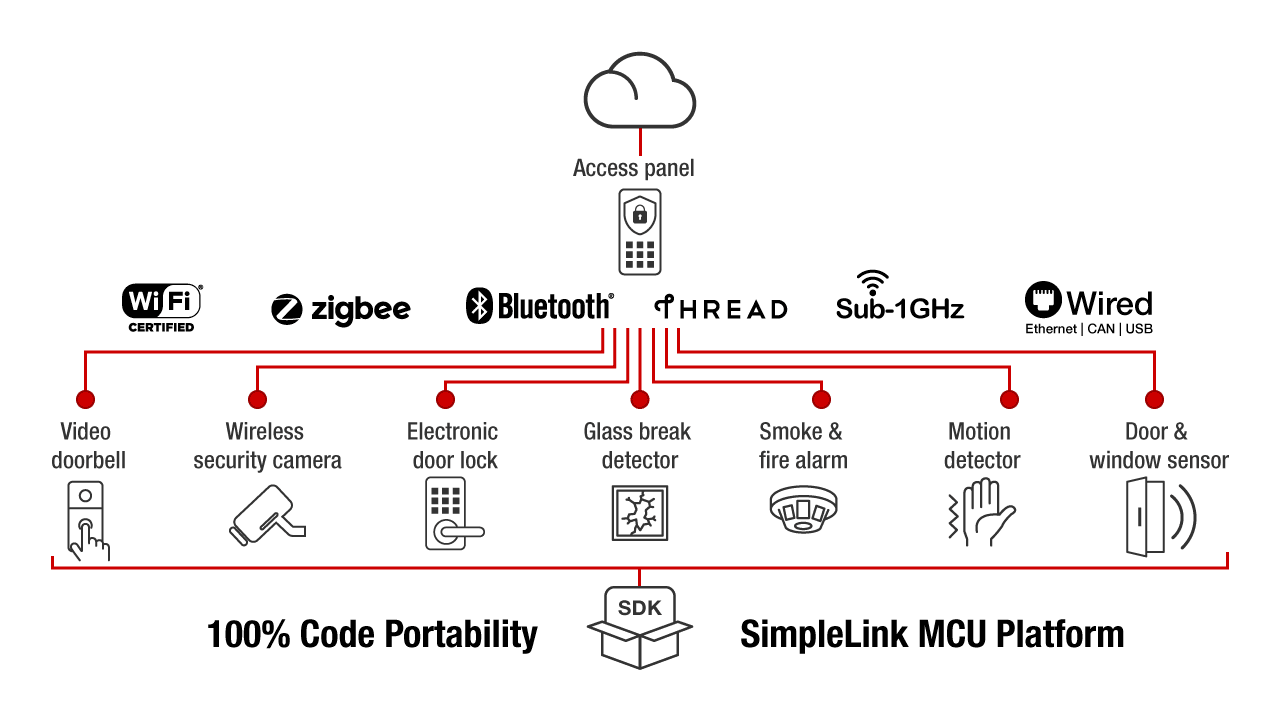There is no way around it: wireless connectivity is changing the world as we know it. And it’s not just wireless earbuds or turning to your smart speaker to ask what the weather is going to be like. It is everything from advanced building security systems to major automotive and medical applications. At the core of this technology are wireless microcontrollers (MCUs) that process data to run software. Shipments of low-power, wireless MCUs are expected to double to over 4 billion units within the next 4 years, resulting in limitless opportunities to evolve this technology.
Why Choose MCUs from Texas Instruments?
To meet this demand Texas Instruments is introducing a range of 16 new wireless MCUs that have low power consumption, more RAM memory, and increased feature capabilities to meet the increasingly complex requirements of the market. Their products offer the flexibility to upgrade or expand products while reusing existing investments, minimizing design cycle times, and optimizing product costs. With their range of options, Texas Instruments is empowering you to innovate, scale and accelerate the deployment of wireless connectivity – no matter what or how you are connecting.
Getting Started: How Do I Choose a Wireless MCU?
Choosing an MCU also means choosing both a and MCU platform, along with numerous communication protocols. Here is what you can expect to find in MCUs from Texas Instruments:
Sub-1 GHz vs 2.4 GHz
When choosing an MCU you will see products labeled Sub-1 GHz, 2.4 GHz, or both. So, which one is most effective for your design goals?
Sub-1 GHz products are still shipping in the greatest volumes by far. They reach a further range than 2.4 GHz products and you can find a lot of home-grown protocols on them. The trend is leaning towards more standardized, official stacks. So instead of having to invent your own stack you can find a solution that matches closest to yours. On the downside, they cannot process large amounts of data so they might not be as suitable for the current complex technologies that are emerging.
On the other hand, 2.4 GHz connectivity solutions and technologies are driving the growth of wireless connectivity. They already have established protocols, such as Bluetooth, but these are continuing to evolve to keep up with the changing landscape of this evolving technology. If you are processing a large amount of data within a smaller environment that does not require a long range, then 2.4 GHz frequency is the perfect solution. After deciding on a frequency range that suits your project, the next step is to decide which MCU development platform is the best fit.
Communication Protocols
When it comes to wireless technologies, you may be looking for a platform that works for Wi-Fi, Bluetooth, Ethernet, Zigbee, and more for applications like home security systems, communications, or even smart tech like autonomous vehicles. With a range of different communication protocols to pick from, it can be confusing and challenging to choose just one. Rather than having to scour through different platforms, Texas Instruments has taken the guesswork out of which platform is the best fit with their SimpleLink and Matter standard program.
SimpleLink
TI’s wireless MCUs use SimpleLink, a wireless MCU platform that can combine essential software components and easy-to-use examples in one comprehensive package. Its SDK is a complete set of validated, fully documented drivers, stacks and code examples that allows engineers to innovate and invent applications with the SimpleLink connected-MCU family.

This platform offers:
- Unified platform: The broadest portfolio of wireless Arm®-based MCUs with low power, advanced security features and support for a range of connectivity protocols.
- 100% code portability: Hardware and software tools with device code portability and a complete set of validated, fully documented drivers and stacks.
- Security from the edge to the cloud: Sophisticated security features specifically designed for IoT devices.
- Low-power performance: Expertise in low-power RF for any power constraint.
Connectivity Standards
The Matter standard is a single, unified connectivity standard based on TI’s SimpleLink platform. It can connect compatible devices and systems, providing a common layer for device life-cycle events over an IP link (like Thread, Wi-Fi, or Ethernet). This standardized model for data and processing is built on proven technologies to simplify development for manufacturers and increase compatibility for consumers.
Matter-enabled devices can operate in 2 different configurations:
- System on Chip: (SOC) runs all Matter layers on a single device. It is a good fit for systems where the main function is Matter and is commonly used for higher-volume products like lights or sensors.
- Co-Processor: runs a subset of Matter layers and pairs with another main processor to create a complete solution.
Learn more about the Matter standard in TI’s FAQ.
Ready to explore TI’s wireless MCUs? Here are a few of their featured products:
CC1352P7
SimpleLink™ Arm® Cortex®-M4F multiprotocol sub-1 GHz and 2.4-GHz wireless MCU integrated power amp
Multiprotocol and multiband wireless MCU with an integrated power amplifier.
Supported Technologies:
- Wi-SUN
- Amazon Sidewalk
- Zigbee
- Thread
- Bluetooth Low Energy 5.2
- TI 15.4 Stack
- Proprietary RF
Flash Memory: 704 kB
SRAM + Cache Memory: 152 kB
CC2652R7
SimpleLink™ Arm® Cortex®-M4F multiprotocol 2.4-GHz wireless MCU with 704-kB flash
Higher memory, multiprotocol wireless MCU.
Supported Technologies:
- Matter
- Bluetooth Low Energy 5.2
- Bluetooth Mesh
- Zigbee 3.0
- Thread
- Proprietary 15.4
Flash Memory: 704 kB
SRAM + Cache Memory: 152 kB
CC2652RSIP
SimpleLink™ multiprotocol 2.4-GHz wireless system-in-package module with 352-KB memory
7-mm-by-7-mm system-in-package wireless module.
Supported Technologies:
- Bluetooth Low Energy 5.2
- Bluetooth Mesh
- Zigbee 3.0
- Thread
- Proprietary 15.4
Flash Memory: 352 kB
SRAM + Cache Memory: 88 kB
Are you or your team designing a connected device? Make sure to browse through TI’s comprehensive series of wireless MCUs and learn more on their website.